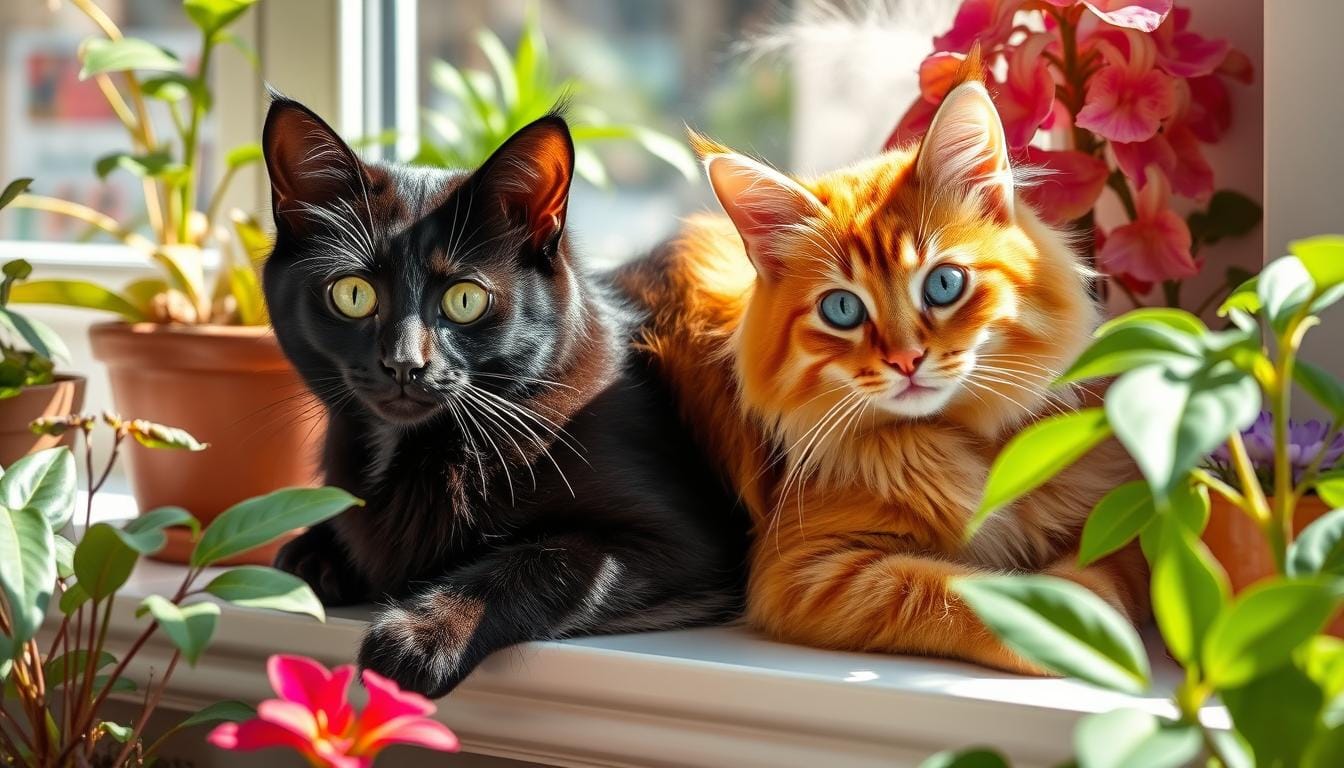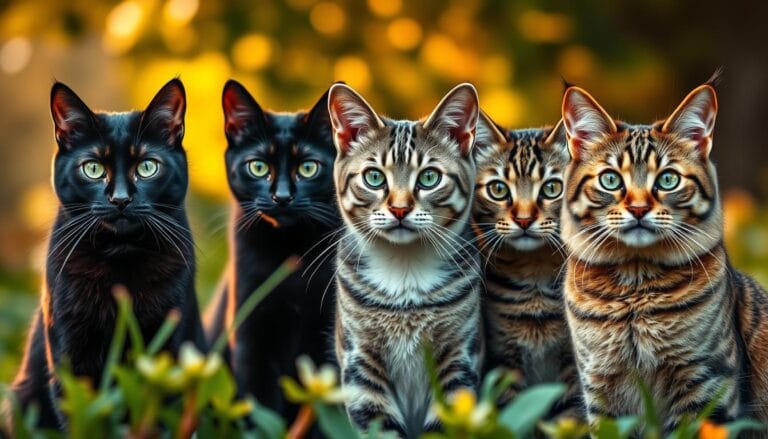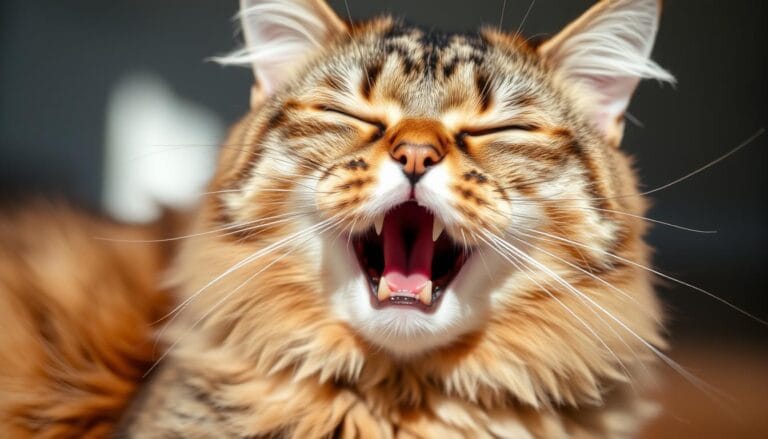Chimera Cat: Understand Their Unique Traits
Have you heard of chimera cats? These rare and fascinating creatures come from two different embryos merging during early pregnancy. This results in a cat with two distinct DNA sets. Their rarity makes them a unique phenomenon in the feline world.
So, what makes a chimera cat special? How do they differ from other cats? In this article, we’ll explore the world of chimera cats. We’ll look at their genetics, characteristics, and what makes them unique.
Table of Contents
Chimera cats are a rare genetic phenomenon. Their unique traits have captured the hearts of many cat lovers. As you learn more about these fascinating felines, you’ll discover their distinct characteristics. Whether you’re a seasoned cat owner or just a feline enthusiast, the world of chimera cats is both intriguing and captivating.
Key Takeaways
- Chimera cats are a rare genetic phenomenon resulting from the fusion of cells from two different embryos.
- They have two distinct sets of DNA, making them genetically unique.
- Chimera cats are exceptionally rare, with a low probability of being born.
- They have distinct characteristics that set them apart from other cats.
- Chimera cats are a fascinating phenomenon that has captured the hearts of many cat lovers.
- Learning about chimera cats can help you appreciate the unique traits and characteristics of these rare felines.
- Understanding the genetics and characteristics of chimera cats can help you better appreciate the world of felines.
What Is a Chimera Cat?
A chimera cat, also known as a two faced cat, is a rare genetic phenomenon. It happens when two fertilized eggs fuse together. This results in a cat with two distinct sets of DNA.
This unique formation can lead to a cat with two different coat colors. They are a fascinating sight to behold.
When you look at a chimera cat, you may notice two distinct colors on their fur. There’s a clear division between the two. This is because the fusion of the two eggs has resulted in a cat with two separate sets of genetic material.
Each set contributes to the development of the cat’s coat color.
Definition of Feline Chimerism
Feline chimerism is a rare occurrence. It happens when two separate embryos fuse together. This results in a cat with four sets of parent cells.
This can lead to a range of unique characteristics. These include different coat colors, eye colors, and even different personalities.
How Chimera Cats Form
Chimera cats are formed when two fertilized eggs fuse together. This results in an embryo with two distinct sets of DNA.
This fusion can occur in the early stages of embryonic development. It results in a cat with two distinct coat colors. For example, a chimera cat may have one side of its face with black fur and the other side with white fur.
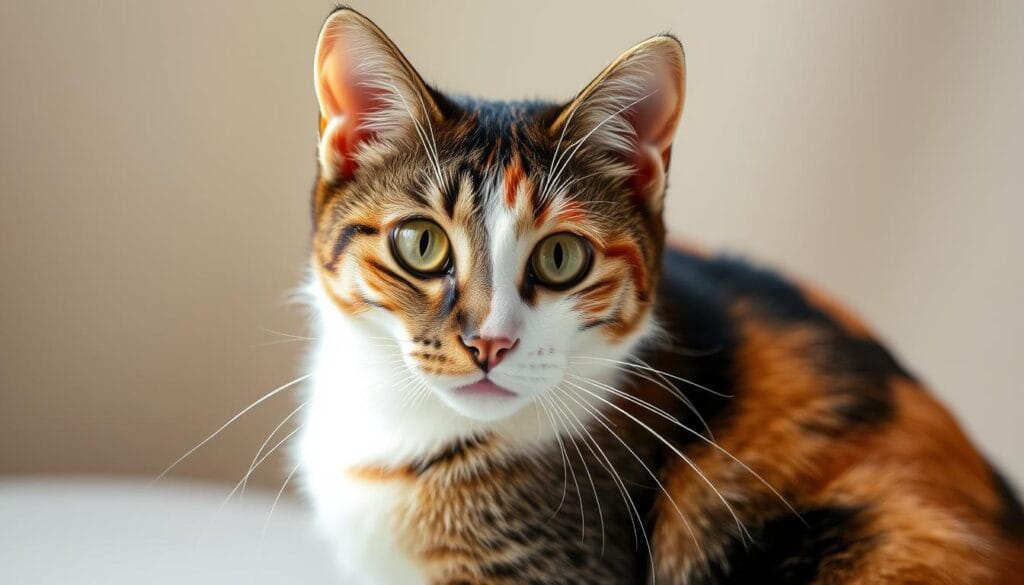
Why They’re Called Chimeras
Chimera cats are called chimeras because they are formed from two separate embryos. They are a unique and fascinating phenomenon.
The term “chimera” comes from Greek mythology. In mythology, a chimera was a creature with the head of a lion, the body of a goat, and the tail of a serpent. Similar to the mythological creature, chimera cats are a mix of two different genetic materials. They are a one-of-a-kind creature.
The Fascinating Genetics Behind Two-Faced Cats
Exploring the genetics of chimera cats is key. These cats, with their split faces, come from two fertilized eggs merging. This rare event happens in about 1 in 3,000 cat births. It makes chimera cats a captivating study subject.
The genetics of these cats are complex. The fusion of two eggs can create unique coat colors and patterns. Some chimera cats may show heterochromia, with different eye colors. Others have split faces or colored eyes. About 60% of chimera cats have these unique features, showing genetic diversity.
Here are some key facts about the genetics of chimera cats:
- Chimera cats can display a variety of fur colors, including combinations of black, white, orange, and more.
- Internal organ differences may include the presence of two different blood types.
- Visual inspection is the most common method to identify a chimera cat, while genetic testing can definitively confirm chimerism through DNA analysis.
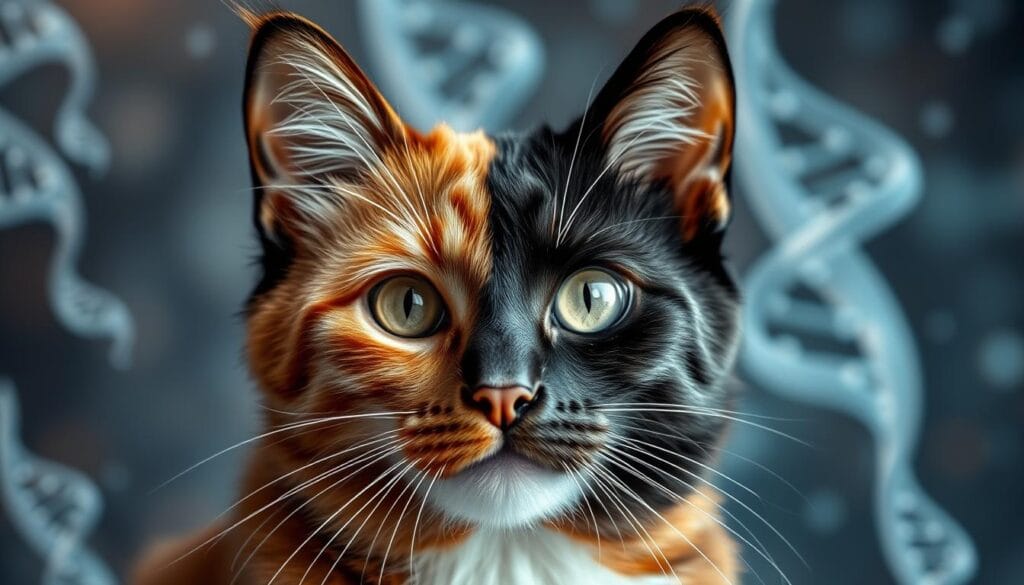
Understanding chimera cat genetics helps us appreciate their uniqueness. Whether you’re a cat breeder or just love cats, studying chimera cats is fascinating. It offers insights into genetics and the natural world.
Identifying a True Chimera Cat
To spot a true chimera cat, look for unique physical traits. These include a mix of two colors on each side of the body. While this is a clue, it’s not the only sign.
Other signs include common color patterns. These patterns show a mix of two distinct colors. This can hint at chimerism in chimera cats.
Some common signs of chimerism in two faced cat include:
- Different colored eyes, also known as heterochromia
- A mix of two distinct colors on the fur
- Genetic testing revealing an XX/XY composition in all or some tissues
Genetic testing is the only sure way to confirm chimerism in cats. DNA testing can show a cat’s genetic makeup. This helps us understand and appreciate these unique animals.
Chimerism isn’t just found in cats. It can happen in other animals, like cattle. Studying chimera cats and two faced cats helps us learn about animal genetics.
Famous Chimera Cats in Social Media
Chimera cats have become stars on social media. They are famous for their unique looks. The cat venus is a prime example. She has two faces, one black and the other orange, and has a huge fan base.
Quimera is another famous cat. She has tabby fur on one side and black fur on the other. Her hazel and blue eyes add to her charm. These cats have not only gained fans but also raised awareness about their rare condition.
- Venus has over 1.4 million followers on Instagram
- Quimera has more than 34,000 followers on Instagram
- Chimera cats can have two different blood types, signifying their unique genetic makeup
These cats are ambassadors for their condition. They show the beauty and diversity of feline genetics.
Common Misconceptions About Split-Faced Cats
When you learn about chimera cats, you might hear some wrong ideas. One myth is that all chimera cats have two faces with different colors. But, this isn’t true for all of them. Some chimera cats show this, but others have a mix of colors that’s not so obvious.
Another wrong idea is that any cat with different colors is a chimera cat. This is not right. Cats with similar patterns might come from genetic changes or other reasons. For example, tortoiseshell cats aren’t chimera cats. They have a common genetic pattern. Here are some important facts about chimera cats:
- They are rare, formed by the joining of two early embryos.
- They have two sets of DNA, making them genetically different from other cats.
- They can have a variety of coat patterns, from slight to very noticeable.
It’s important to know that chimera cats are different from other cats with mixed colors, like calico or tortoiseshell cats. Even though they might look similar, they come from a different genetic reason. By understanding more about chimera cats and their special traits, we can truly appreciate these amazing animals and the science behind them.
Health and Lifespan of Chimera Cats
As a cat owner, you might wonder about your cat’s health and lifespan, like if it’s a two faced cat. The good news is that chimera-cats, including those with split faces, usually live as long as non-chimera cats. They can live about 16 years on average.
But, it’s important to think about the health risks of chimerism. Because chimera cats have two sets of DNA, they might face more genetic disorders. Regular veterinary check-ups are key to keep an eye on their health and catch any problems early.
Some important things to remember about the health and lifespan of chimera-cats include:
- Genetic health implications: Chimera cats might be more likely to get genetic disorders because of their unique DNA.
- Medical considerations: It’s vital to have regular check-ups and watch for health issues to keep your cat with split face healthy.
- Life expectancy: While chimera-cats can live up to 16 years or more, their lifespan can be influenced by their genetics and health.
By knowing the health risks and taking steps to keep your chimera cat healthy, you can help them live a long and joyful life. Whether your cat has a split face or is two faced, giving them the right care and attention is key to their happiness and health.
Caring for Your Chimera Cat
As a chimera cat owner, you want to give your pet the best care. Caring for a chimera-cat is like caring for any cat, but there are special things to remember. Regular veterinary check-ups are key to keep them healthy and catch problems early.
Here are some tips for caring for your chimera-cat:
- Provide a balanced diet that meets their nutritional needs
- Regular grooming to prevent matting and tangling of the fur, and to keep the coat clean and healthy
- Ensure your chimera cat gets enough exercise and playtime to stay happy and healthy
It’s also important to think about your chimera-cat’s unique genetic makeup. They might face certain health issues because they have two sets of DNA.
By following these tips and working with your vet, you can help your chimera-cat live a long, healthy life. Remember, every chimera-cat is different. So, it’s important to tailor your care to their individual needs. With the right care and attention, your chimera cat can thrive and bring joy and companionship to your life.
The Difference Between Chimera Cats and Other Unusual Color Patterns
If you own a cat, you might have seen cats with unique fur patterns. These include tortoiseshell and calico cats. But, these patterns are often mixed up with the rare two faced cat or cat with split face, known as Chimera Cats. Let’s look at what makes each different.
Chimera-Cats have a special pattern on each side of their body. This makes them truly unique. Tortoiseshell cats, on the other hand, have a mix of orange and black fur. Calico cats have white fur with orange and black patches. The main difference is in their genes. Chimera-Cats have two different genetic codes, making them special.
Key Characteristics of Each Breed
- Tortoiseshell cats: mix of two colors, typically orange and black, swirled together
- Calico cats: predominantly white coat with patches of orange and black
- Chimera-Cats: distinct color pattern on each side of the body, with two different genetic codes
In short, while tortoiseshell and calico cats have cool fur patterns, they’re not the same as the rare two faced cat or cat with split face. Knowing the differences helps us appreciate our cats’ unique beauty.
Breeding and Genetics: Can You Breed Chimera-Cats?
Chimera-cat breeding is complex and challenging. It involves understanding the genetics of these cats. When two embryos merge early, a chimera-cat forms, having two sets of DNA.
Creating chimera-cats is rare and requires specific genetic combinations. While mosaicism is common in calico or tortoiseshell cats, chimerism is much rarer. This makes predicting traits in offspring difficult.
Understanding Inheritance Patterns
To breed chimera cats, knowing genetic mutations in embryos is key. About 1 in 3,000 calico or tortoiseshell cats may show mosaicism. But, the rate of chimerism is unknown, and a vet should be consulted if you suspect it in your cat.
Ethical Considerations
When breeding chimera-cats, health risks must be considered. These risks include autoimmune diseases and organ failure. While data on chimeras’ health is limited, responsible breeding focuses on animal welfare. Breeders must understand chimera-cat genetics to make informed decisions and protect these unique animals.
Photography Tips for Capturing Your Chimera Cat’s Unique Features
Photography is key to capturing your Chimera Cat’s special features, like the cat venus. Understanding the basics of photography is essential. This includes lighting, composition, and camera settings. Natural light is always best, so take photos near a window or outside.
Try different angles and compositions to highlight your cat’s split face. Be creative and try new things. For instance, shoot from a low angle to focus on their face. Or use a macro lens to show off their fur details.
Here are some tips for photographing your Chimera-Cat:
- Use a tripod to keep the camera steady and avoid blur
- Play with different aperture settings to control the depth of field
- Choose a plain or neutral background to focus on your cat
By following these tips and practicing, you can take amazing photos of your Chimera Cat. This includes the cat venus. Show off their unique features to everyone.
Conclusion: Embracing the Uniqueness of Chimera-Cats
As we wrap up our exploration of chimera cats, it’s clear they are truly special. Their unique genetics and striking looks amaze cat lovers everywhere. By valuing their uniqueness, we can help protect and conserve them.
Their fur patterns and eye colors show the beauty of genetic diversity. Though rare, with about 1 in 1,000 births, their fame on social media is growing. For example, Venus the Two-Faced Cat has 2.5 million followers.
When you encounter chimera-cats, celebrate their uniqueness. Give them the care they need and honor their place in the cat world. This way, you’ll not only make your life richer but also help preserve these amazing animals.
FAQ
What is a Chimera-Cat?
A Chimera Cat is a rare feline. It happens when two fertilized eggs merge. This creates a cat with two distinct DNA sets. This genetic phenomenon is called feline chimerism.
How are Chimera-Cats formed?
Chimera-Cats form when two fertilized eggs merge early in development. This merge leads to a cat with two DNA sets. This can result in unique coat colors and patterns.
Why are Chimera-Cats called Chimeras?
They are called Chimeras because they come from two embryos. This makes them unique and fascinating. The term “Chimera” comes from a mythical creature made of different animal parts.
How can you identify a true Chimera-Cat?
Spotting a true Chimera-Cat is tricky. Look for physical signs like a distinct color pattern on each side. Also, check for common patterns like mixed colors. DNA testing is also key.
What are some famous Chimera-Cats that have gained popularity on social media?
Famous Chimera-Cats include Venus, a two-faced cat. Quimera and Narnia have also won many hearts on social media.
What are some common misconceptions about Chimera-Cats?
Many think Chimera-Cats are always two-faced. But, this isn’t true for all. Some have subtle color mixes. Not all cats with unique patterns are Chimeras.
How does the health and lifespan of Chimera-Cats compare to non-Chimera cats?
Chimera-Cats’ health and lifespan are usually like non-Chimeras. But, they might face genetic disorder risks. They could also live shorter lives due to these risks.
What are the key differences between Chimera-Cats and other unusual color patterns like tortoiseshell and calico?
The big difference is in their color patterns. Chimera-Cats have distinct patterns on each side. Tortoiseshell and calico cats have mixed colors all over.
Can Chimera-Cats be bred?
Breeding Chimera-Cats is complex and challenging. It requires understanding genetics and inheritance. There are also ethical concerns, like health risks and animal welfare.
There are no reviews yet. Be the first one to write one.

